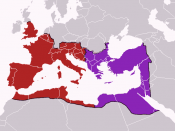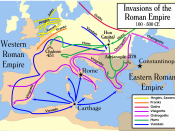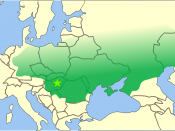In 410 CE, the city of Rome was sacked by the Visigoths led by the chieftain Alaric. By 476, the largest and longest lasting empire the world had ever seen and will ever see again had collapsed. How did this happen? This sudden collapse was really a 300 year process that can be explained by three features of the empire during and after the reign of the five good emperors . The first and most significant feature, was the constant murder and replacement of the emperor and his government, "The previous eighty-four years had seen just five emperors; during the next 104 , there were twenty-nine" . The second cause was the loss of the loyal citizenry that had made the empire so resilient to invaders, "Another cause of disorder and weakness was intercity warfare. Owing to Rome's centuries old policy of 'divide and rule,' feelings of mutual hatred persisted among neighboring [sic] cities not only preventing co-operation but on occasions leading to intercity mob warfare."
The final cause was the invasion of Eastern Europe by the Huns, lead by Attila, forcing three different barbarian tribes into Roman territories.
The constant civil war and regicide in which the Romans were engaged caused an incoherent policy in all regions and allowed the empire to reach a state of decay unseen before. As stated in the introduction, after the reign of the five good emperors, the empire went through a period with an average of one emperor every 3 and a half years. As Isaac states, "[I}t has been calculated that between 133 [BCE] and 394 [CE], on average, one year in every seven was given over to civil war." A prime example of typical Roman government at this time is embodied by Kamm in this statement, "There followed a similar ominous...


